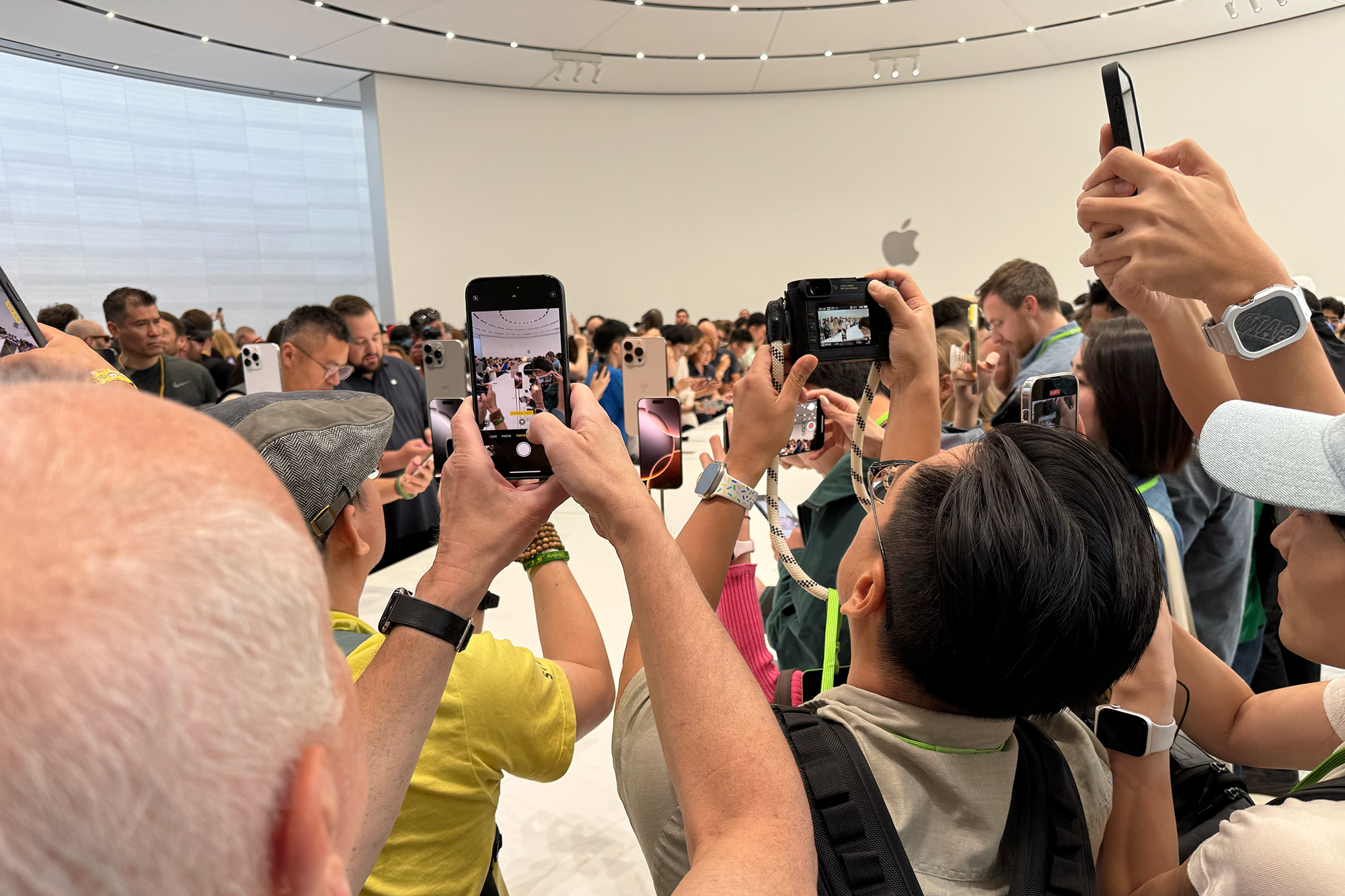

We may earn revenue from the products available on this page and participate in affiliate programs. Learn more ›
Like clockwork, Apple introduced its latest smartphones and wearables at an event held at its headquarters in Cupertino, Calif. PopSci was invited to attend in-person to check out the new gadgets, which are currently available for preorder and will be released on Sept. 20.
The “It’s Glowtime” event, named after the glowing halo that circles your phone screen when using Siri in iOS 18, provided demonstrative improvements to Apple’s non-pro devices, which are getting their most meaningful updates in years. Apple is also putting its hat into the AI ring, offering features and hardware that catch up to rival AI initiatives on Android phones.
Apple Watch 10: X marks the spot

The Watch’s 10th birthday isn’t until next April, but Apple decided to celebrate early with the Apple Watch Series 10. The new smartwatch is both smaller (in volume) and bigger (in screen size) than any previously released Apple Watch. The Apple Watch Series 10 is available in 42mm and 46mm screen size configurations, up from the 41mm and 45mm displays available on previous Apple Watches. One millimeter may not seem like a lot, but it’s a big enough boost in resolution to see an additional line in text messages and other apps.
In-person, the Series 10’s display is big and bright, which is what you want from a device that you’ll peer at periodically throughout the day. While the new Apple Watch Series 10 models weigh only slightly lighter than their predecessors—the exact amount will vary based on the size and material you choose—it’s welcome when you have it in your hand or on your wrist.
The Apple Watch Series 10’s speaker system has been updated to play music or podcasts through it. Similarly, the Apple Watch Series 10’s microphone system now incorporates voice isolation, which can be helpful when taking calls or recording voice memos. A new water temperature sensor and depth gauge allows you to track dives up to 20 feet below sea level, and enables you to use the Oceanic+ app for snorkeling. Additionally, the Apple Watch Series 10 can be used to track sleep apnea. This feature will be introduced to the Apple Watch Ultra 2 via a software update this fall. Additionally, the company announced a new black titanium colorway with matching Milanese band.
The Apple Watch Series 10’s most tangible feature is its faster charging. Apple says the Series 10 can charge 80% of its battery in about 30 minutes, which is 15 minutes faster than the Series 9. Despite these improvements, Apple hasn’t increased the Series 10’s price. It still starts at $399 for the GPS model and $499 for a version with a cellular antenna.
AirPods: High-end features in lower-cost earbuds, Max gets new colors

While Apple introduced new features across the entire AirPods line, it spent the lion’s share of its time discussing the next generation of its entry-level earbuds. Until today, the least expensive earbuds offered were the second-generation AirPods, which debuted in 2019. The AirPods 4 are a significant improvement over those earbuds and the AirPods 3, which were introduced in late 2021.
The earbuds and case are both smaller than before, and they feel lightweight in your ears and hand, respectively. This new design is coupled with a processor bump that brings the AirPods 4 into alignment with the AirPods Pro. Additional improvements over the 3rd generation AirPods include dust resistance, voice isolation, personalized volume, Bluetooth 5.3 support (up from Bluetooth 5.0), and a new vent system for pressure equalization.
The AirPods 4 are now available in a configuration that includes active noise cancellation (ANC). This feature was previously exclusively available on the AirPods Pro; previous non-Pro AirPods don’t have a gummy tip, meaning they can’t create a tight seal around your ear that’s typically required for ANC. To compensate, the aptly-named AirPods 4 with Active Noise Cancellation uses microphones to greatly reduce certain frequencies associated with common noises like cars and airplane engines. Like the AirPods Pro, the AirPods 4 now include Apple’s H2 chip, adaptive audio, transparency mode, and conversation awareness.
The AirPods 4 and AirPods 4 with Active Noise Cancellation will be available for $129 and $179, respectively.

Apple announced a minor update to the AirPods Max, which are now available in a configuration with a USB-C port. They are available at the same $549 price as their predecessor. Additionally, the AirPods Max come in new colors: Blue, purple, midnight, starlight, and orange.
While Apple didn’t update the AirPods Pro line with new hardware, it did announce a software update landing this fall that will introduce new features, including the ability to initiate a hearing test and use the AirPods Pro 2 as over-the-counter hearing aids.
iPhone 16: Smartly designed inside and out

Apple’s September hardware announcements tend to introduce new iPhones, and this year is no different. Apple began by showcasing the iPhone 16 and iPhone 16 Plus, which leapfrogs two processor generations from the A16 Bionic to A18 processor. Apple has stuck its non-Pro iPhones with the previous generation Pro processors for a couple of years, but ran into a big problem: Apple Intelligence. The AI features it introduced at its Worldwide Developers Conference (WWDC) this June would only be available in the iPhone 15 Pro phones due to resource constraints. That’s no longer a concern thanks to the processor update.
Apple says the A18 processor has a CPU (central processing unit) and GPU (graphics processing unit) that are 30% and 40% faster than the A16 Bionic. The iPhone 16 can handle the same load as its predecessor while consuming 30% less power. If you’re not using your iPhone to constantly shoot 4K video and play games, you’ll notice a battery improvement.
The iPhone’s outer case now includes the action button originally introduced last year in the iPhone 15 Pro. This button can be mapped to open apps or run shortcut automation in a single press, which can save you time. Apple also introduced a new Camera Control button. This touch-sensitive surface is a strip on the side of the iPhone 16 that reacts to pushes and swipes.
Pushing on the Camera Control button will open the Camera app; pushing it again will take a picture. A long press records a video. Lightly pushing on this section of the iPhone will bring up different photo settings. You can swipe through this menu to reveal different options, which you can select by pushing lightly again. This felt natural immediately in our hands-on experience and will become indispensable for iPhone photographers who need to take fast shots and care about changing their focus, F-stop, and zoom level without touching the screen.
The introduction of this camera feature coincides with improvements to the iPhone’s 16’s camera system. The iPhone’s main and ultrawide lenses are stacked on top of one another, which allows the smartphone to record spatial video. The main camera has been updated to support macro photography and new photographic styles, too. The ultrawide camera has been update to capture 2.6x more light, too, which will help with low-light photography. If you record a lot of video with your iPhone, you’ll appreciate the iPhone 16’s new “Audio Mixer” feature, which allows you to use its new microphone system to hone in on different sounds, like voices of people who are in frame, or capturing ambient noise while boosting voices to create a fuller portrait of the scene.
While the big improvements to the iPhone 16’s physical appearance are buttons (and a slate of colors that’s energetic and easy on the eyes), it’s also been outfitted with a brand-new aluminum enclosure and a screen made from glass that’s twice as tough as any other smartphone display. This is helpful for those prone to dropping their iPhone and don’t want to use a screen protector. Apple says the iPhone 16’s design has also been updated to dissipate heat more evenly. This is especially important now that the iPhone supports wireless charging at up to 25 watts, up from 15 watts.
Apple’s iPhone 16 line starts at $799.
iPhone 16 Pro: Apple’s latest and greatest

The improvements Apple made to the iPhone 16 line allowed the company to push the envelope even further with the iPhone 16 Pro and Pro Max. The biggest immediate difference is an increase in screen size, with the iPhone 16 Pro jumping from 6.1 to 6.3 inches and the Pro Max stretching out from 6.7 to 6.9 inches. These pocket-busting sizes may be too big for some, but do provide a little extra digital space for those who need it.
Apple’s premium iPhones also get the new touch-sensitive camera button and more durable screen available on the non-Pro models, though the CPU and GPU improvements over last year’s models are more modest (15% and 20% better, respectively). Apple has made larger gains in the battery department, boasting up to four more hours of use per charge than the iPhone 15 Pro and 15 Pro Max. Smaller technical updates include support for Wi-Fi 7 (previous iPhones only supported Wi-Fi 6e) and an even more precise GPS chip.
The new iPhones receive Apple’s best camera system ever, with the Ultrawide camera jumping up from 12 to 48 megapixels, and the ability to shoot 4K video at up to 120 frames per second. You also have the ability to slow that video down to 60, 30, and 24 frames per second through the Photos app. The front-facing camera system remains unchanged. While the updates to the iPhone 16 Pro are more modest than the jump from the iPhone 15 to iPhone 16, they’re meaningful and will improve the day-to-day use of Apple’s best phone.
The iPhone 16 Pro line starts at $999.
